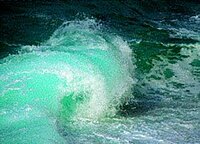Wind and Waves

Spaceborne altimeters measure sea surface height first and foremost, but we can also obtain other physical parameters using satellite altimetry techniques. One such example is wave height, which is of prime importance to marine weather forecasters and ships at sea. Wave height can be derived by looking at how the sea surface reflects the radar signal.




